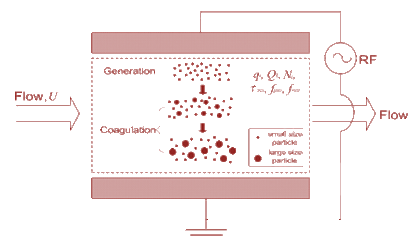|
|
|

|
| Particle Contamination Control in Semiconductor Processing |
 |
| Model of particle growth in silane plasma reactor |
Particle contamination control is quite important in the plasma reactor
and much research on particle growth has been done theoretically and
experimentally. The particles follow three phases initial growth phase,
rapid growth phase, and growth saturation phase) to grow up to submicron
sizes. The particle growth in plasma reactor are investigated by using
the discrete-monodisperse (D-M) model for various process conditions,
considering effects of a particle charge distribution based on the
Gaussian distribution function. At the start of the plasma discharge,
there is the high concentration of small-size particles, and later
large-size particles appear and grow by coagulation between small-size
particles. Some fractions of small-size particles are in a neutral
state or even charged positively. The positively charged small-size
particles coagulate faster and more selectively with large-size particles,
which are charged more negatively than with medium-size particles.
Also, the particle-size distribution in a plasma reactor becomes bimodal
and large-size particles become quite monodisperse. As the mass generation
rate of monomers increase or as the monomer diameter decreases, large-size
particles grow more quickly and the particle-size distribution becomes
bimodal earlier.
The plasma reactor can be a good candidate to produce monodisperse,
nanosized particles. |
|
|
|
|
|
|
